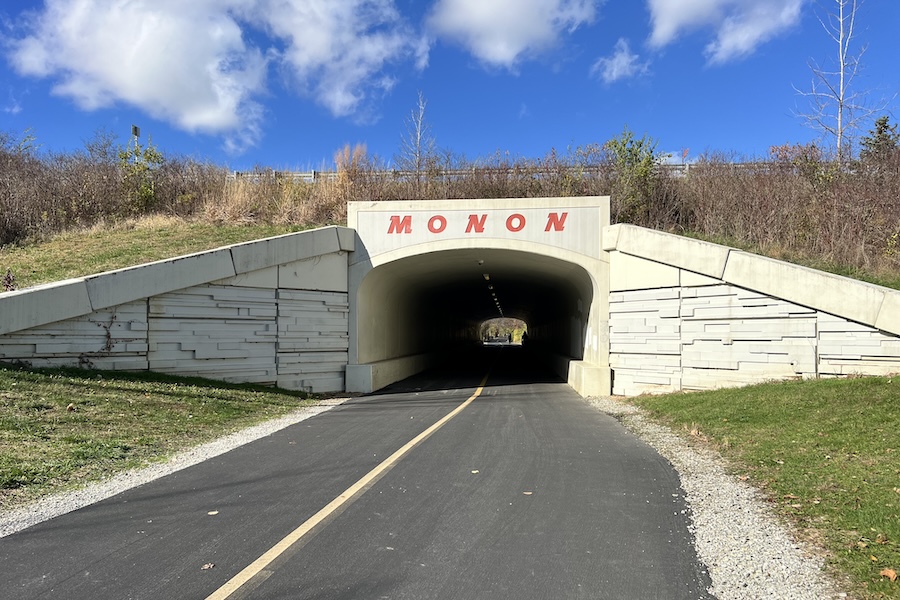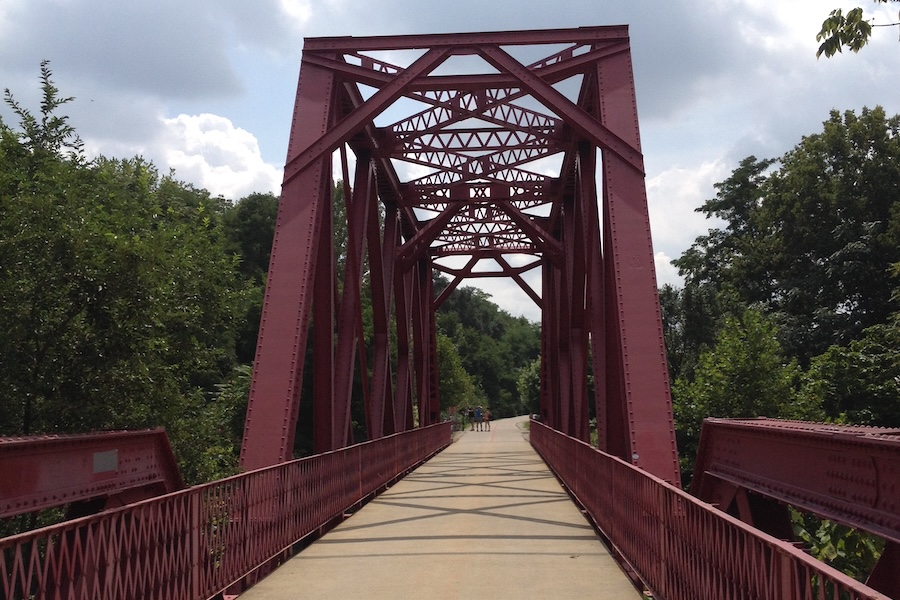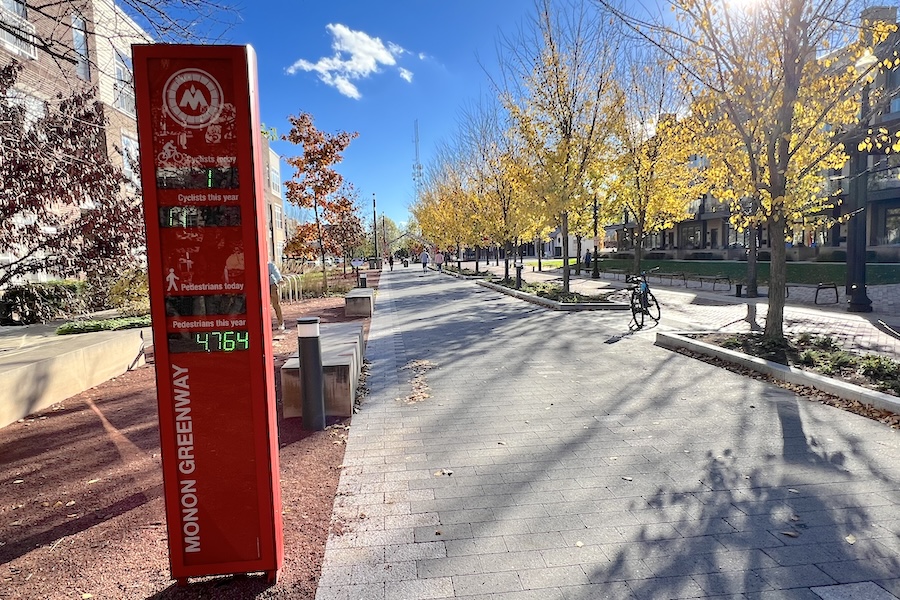Indiana’s Monon Trail

Trail of the Month: December 2024
Passing through the heart of Indianapolis, Carmel, Westfield and Sheridan, Indiana’s Monon Trail is more than a greenway; it’s a commuter super-highway, a linear park for families, an inexpensive way for folks to get exercise. In many ways, it’s the asphalt lifeblood of those Hoosier communities.
“It has reshaped our cityscape, inspiring public-private partnerships that prioritize people over vehicles.”
—Larysa Glaspie, Carmel’s senior project manager of redevelopment
“What the Monon lacks in grand vistas, it makes up for in shady neighborhoods and a close feeling to the communities it runs through,” said Greg Dyas, who commutes via the trail from his Carmel home to downtown Indianapolis multiple days a week. “On about half my rides home, I’ll pass a friend or acquaintance. I’ll also use it for errands on evenings and weekends and short runs for fitness.”

The popular Mass Ave Cultural Arts District serves as the Monon’s southern terminus, connecting to the Indianapolis Cultural Trail in the city’s bustling downtown. Colorful murals decorate exterior walls and fences along the route, with the Indianapolis Art Center’s ARTPARK—designed by Hoosier native Michael Graves and filled with dozens of intriguing sculptures—a popular detour in the Broad Ripple neighborhood.
Farther north, in Carmel’s Midtown, the Monon offers a small-town Americana feel, with families ambling from the shops to the trailside playgrounds to Bub’s Burgers for ice cream.

“The transformation of the Monon Trail in Carmel—from an old railroad to a vibrant, human-centric urban trail—has sparked a wave of catalytic development,” said Larysa Glaspie, Carmel’s senior project manager of redevelopment. “It has reshaped our cityscape, inspiring public-private partnerships that prioritize people over vehicles.”
In Carmel alone, Glaspie estimates that the Monon has helped attract more than $250 million in development since it was built.

Leaving Carmel and heading into Westfield, the Monon passes by the Grand Park Sports Campus, a major youth sports facility that routinely hosts national baseball and basketball tournaments, as well as the NFL’s Indianapolis Colts training camp. By the time it reaches Sheridan, the Monon takes on a more rural flavor.
Traveling along the entirety of this Hall of Fame rail-trail, you see multiple connections from neighborhoods, retirement communities and businesses.
The Monon’s History

The Monon Trail is named after the railroad that ran from Louisville through Indianapolis and on to Chicago. Originally formed in 1847 as the New Albany & Salem Railroad, it changed names multiple times over the next century, mainly reflecting its primary ports of call. Perhaps the most noteworthy event in its history was transporting President Abraham Lincoln’s body during his funeral procession to Illinois.
From almost the beginning, the route’s nickname was the Monon, a native Potawatomi term—or at least the white settlers’ interpretation of it—meaning “swift running.” The railroad would officially change its name to the Monon in 1956, three years before it ended passenger service from Chicago to Indianapolis. Amtrak would run passenger service on the Monon rail lines into Indianapolis until 1979. Some of the rail lines, those leading north into Chicago and south of Delphi, Indiana, remain in use by both CSX and Amtrak.
The disused Monon rail line fell into disrepair by the late 1980s, when a group of residents and business owners led by local activist Thomas Healy broached the idea of a rail-trail to Indianapolis. An avid bicyclist, Healy saw other abandoned rail lines transformed into multiuse trails elsewhere in the country and decided that was an ideal solution for the former Monon line.
“The rail line had become a dumping ground and eyesore,” Healy told Rails to Trails in an earlier interview. “We saw so much potential, both for recreation and for economic development, but what’s happened with the Monon has far exceeded what we’d envisioned.”
Longtime Indy resident Mark Finney agreed. “Before the Monon, it seemed like only kids and so-called ‘serious cyclists’ rode bicycles in Indianapolis,” Finney said. “Luckily, people had seen the impact of rail-trails and bicycle infrastructure in other places and realized that this was a one-time opportunity for Indianapolis to have fun, get healthy and get around without cars.”

The city purchased the railroad right-of-way, and the first 10-mile section of the trail opened in 1999. Less than two years later, Carmel cut the ribbon on 5.2 miles of trail.
“The people who lived adjacent to the Monon feared having ‘all those people in their backyard,’ because their garages would get broken into and their property value would plummet,” said Finney. “The opposite has been true on both counts, and now the Monon is touted as an example in support of building out more bicycle infrastructure in the area.”
Today, it’s estimated that 1.3 million people traverse the Monon through Indianapolis annually. And a study cited by Indianapolis officials revealed that homes within a half-mile of the Monon Trail command a sales premium of more than $13,000. Extrapolated to the nearly 9,000 homes along the trail, the Monon adds more than $115.7 million in value to homeowners. Developers have built numerous multi-million-dollar developments either alongside the trail or within a few short pedal strokes.
But the construction of the trail also had a darker purpose. After years of complaints from the mostly white residents on Indianapolis’ northside about sewage backups, the city used the initial construction of the Monon to surreptitiously pipe more than 2 million gallons of sewage annually out of wealthy neighborhoods and into the Fall Creek watershed that dumped into the White River, where the surrounding neighborhoods were filled mostly with minority and low-income families. Years after the egregious act of environmental racism, the Environmental Protection Agency would force Indianapolis to remedy the issue with a massive $2 billion tunnel project that continues today.

“On one hand, I see the Monon Trail as a linear park through Indianapolis’s north side,” said Leon Bates, a local historian and activist. “It’s a great way to enjoy the outdoors of an urban area. But on the other hand, I see it as yet another example of environmental racism, of some Indianapolis civic leaders intentionally harming one community for the benefit of another. This was no accident; it was planned. City officials knew in advance what would happen but did it anyway.”
The Monon has steadily expanded over the decades, making its way farther north through Westfield and Sheridan, where a 0.75-mile expansion was completed in the fall of 2024. An additional 1.1-mile expansion will be added in 2025, taking the trail to the Boone County line. Grants from the state’s Next Level Trails program helped make these extensions possible.

A Community Centerpiece

Adding to its value, the Monon links to multiple greenways throughout Marion and Hamilton counties, including the Fall Creek Trail and the Central Canal Towpath. Paralleling the Monon, Hamilton County’s Nickle Plate Trail, built on another former railway through Indianapolis’ northeastern suburbs, is expanding with a spring 2025 completion eyed. With a connection to the Midland Trace Trail in the north, this trail network will give central Indiana residents a 42-mile loop to reach even more destinations.
“Being able to ride away from traffic and being able to relax as I ride from place to place is fantastic,” said Dyas, who looks forward to more trail connections. “That there are so many businesses—restaurants, coffee shops and the like—facing the trail makes it even better.”
Leaving Indianapolis at 96th Street, the trail becomes known as the Monon Greenway as it enters Carmel and Hamilton County. Passing through the Monon Community Center and into Carmel’s Midtown, the Monon takes on a different form, for a few miles at least. Between 2018 and 2020, Carmel embarked on a different type of trail expansion. Called the Monon Boulevard, the path widens for cyclists, with an additional path on either side for walkers through Midtown. The city is currently extending this boulevard out to Rangeline Road, with the bulk of construction to be completed in 2025, and additional infrastructure and landscaping completed by summer 2026.

“The Monon is the centerpiece of Carmel,” said Kevin Whited, Carmel’s transportation development coordinator. “It serves as an economic development tool like a huge lake or other natural feature. People are drawn to the vibrancy of the space, which is why we’re constantly expanding the Monon and other trails. During our monthly Coffee on the Monon events, I’ve had conversations with couples in their 20s and 30s who told me they moved from out of state to Carmel, primarily because of the trail.”
Beyond the already announced expansions, Whited and others dream of one day connecting the trail to both Chicago and Louisville, completing the historic rail line, though he admits that’d be a tall order.
“You know those scenes in movies, where the characters walk through a park and there are hundreds of extras walking around in the background?” asked Whited. “That doesn’t really happen in real life, except for here. People love the Monon.”

Related Links
Carmel-Clay Parks and Recreation
Visit Hamilton County, Indiana
Trail Facts
Name: Monon Trail (In Carmel, the trail is also known as the Monon Greenway.)
Used railroad corridor: Monon Railroad
Trail website: Bike the Monon
Length: 27.1 miles
Counties: Hamilton and Marion
Start point/end point: 10th St. and Bellefontaine St. (Indianapolis) to Opel St. and E. 236th St. (Sheridan)
Surface type: Asphalt
Grade: Flat with a few road overpasses
Uses: Walking, bicycling and inline skating; wheelchair accessible
Difficulty: The trail offers an easy experience as it’s paved and flat with access to numerous amenities along the way.
Getting there: Visitors can fly into Indianapolis International Airport, which is located 14 miles from the southern end of the Monon Trail and is served by most major air carriers. Indianapolis is also served by Amtrak; its Union Station (350 S. Illinois St.) is located about 2 miles from the southern end of the trail.
Access and parking: Parking can be found near most trailheads, particularly south of Broad Ripple, at 86th Street and 96th Street, and farther north in Hamilton County. Parking is also available in the parks along the way, including (from south to north): Canterbury Park (5510 N. Carvel Ave., Indianapolis), Central Park (1235 Central Park Dr. E., Carmel), Quaker Park (17501 Dartown Road, Westfield) and Grand Park (19000 Grand Park Blvd., Westfield).
Rentals: Bicycles and e-bikes can be rented from Indiana Pacers Bike Share at the 16th Street trailhead, the state fairgrounds and the 54th Street trailhead, among others. Additional bike shop options are listed on the Bike the Monon website.

Donate
Everyone deserves access to safe ways to walk, bike, and be active outdoors.
